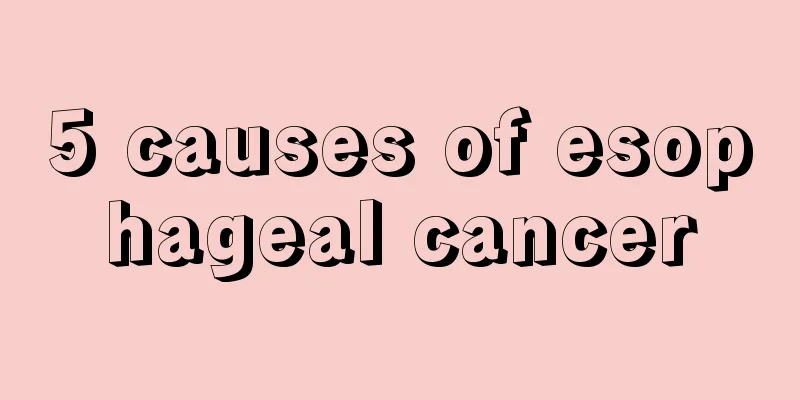5 causes of esophageal cancer

|
The five causes of esophageal cancer include: (I) Nitrosamines and esophageal cancer In 1972, the first report of using nitrosamines to induce esophageal cancer in rats was published in my country, and an animal esophageal cancer model was successfully established, providing a theoretical basis for the nitrosamine etiology of esophageal cancer and its prevention. It was proved that certain nitrosamines can activate human esophageal oncogenes and induce human embryonic esophageal epithelial cancer. Nitrosamines are recognized chemical carcinogens. Their precursors include nitrates, nitrites, secondary or tertiary amines, etc. They are commonly found in food and drinking water in high-incidence areas. The content is significantly increased and positively correlated with the local incidence of esophageal cancer and severe esophageal epithelial hyperplasia. Under acidic conditions in the stomach, especially when vitamin C intake is insufficient, amines and nitrites are easily synthesized into nitrous acid. In China, nitrosamine methylbenzylamine, nitrosamine ethyl sarcosine, nitrosamine methylpentylamine and diethylnitrosamine have been successfully used to induce esophageal cancer in rats. It has also been confirmed that nitrosamines can induce human esophageal squamous cell carcinoma. (II) Fungus and esophageal cancer Since the 1960s, the relationship between mold and tumors has received widespread attention. However, there are few studies abroad on the relationship between mold and esophageal cancer. Various moldy foods can produce carcinogens. Fungi such as Fusarium, Geotrichum candidum, Aspergillus flavus and Aspergillus niger can not only reduce nitrates to nitrites, but also increase the content of secondary amines and promote the synthesis of nitrosamines. The esophageal epithelial cells adjacent to the site of fungal infection may show simple hyperplasia, mild to severe atypical hyperplasia, and even obvious canceration. Pure strains of Candida albicans can be isolated from the hyperplastic epithelium adjacent to esophageal carcinoma in situ. Therefore, esophageal fungal disease may be one of the precancerous lesions of esophageal cancer. 3. Dietary stimulation and esophageal injury and esophageal disease It is generally believed that the roughness of the esophagus, eating too hot food, chewing betel nuts or tobacco, etc., cause the irritation of the esophageal mucosa, which can lead to localized or diffuse epithelial hyperplasia and form the precancerous lesions of esophageal cancer. Esophageal cancer damage and certain chronic esophageal diseases such as corrosive esophageal burns and stenosis, gastroesophageal reflux disease, esophageal achalasia or esophageal diverticulum, etc., due to the retention of esophageal contents, cause long-term chronic inflammation, ulcers, or chronic irritation, causing esophageal epithelial hyperplasia and leading to cancer. 4. Malnutrition and trace element deficiency Whether at home or abroad, the high-incidence areas of esophageal cancer are all in poor and underdeveloped areas with poor natural conditions, less water resources, less production, and food shortages. The diet lacks animal protein, fat, fresh vegetables and fruits. The intake of vitamin A, vitamin B12 and vitamin C is insufficient. Epidemiological surveys have shown that the content of molybdenum, copper, boron, zinc, magnesium and iron in food, drinking water and soil is low. These may be indirectly related to the occurrence of esophageal cancer. For example, the trace element molybdenum is an important component of certain oxidases and nitrate reductases. Molybdenum deficiency can cause the accumulation of nitrates in plants. (V) Genetic factors The incidence of esophageal cancer often shows familial clustering. In high-incidence areas of my country, 25%-50% of people have a positive family history of the disease, with the highest rate in the paternal line, followed by the maternal line, and the lowest in the collateral line. The chromosome aberration rate of peripheral blood lymphocytes in high-incidence families of esophageal cancer is relatively high, which may be a genetic factor that determines the susceptibility to esophageal cancer in high-incidence areas. The survey also found that after the residents of the high-incidence area of Linzhou moved to other counties, the incidence and mortality of esophageal cancer remained at a high level. These phenomena indicate that heredity has a certain relationship with esophageal cancer. |
<<: Differential diagnosis of early esophageal cancer
>>: Differential diagnosis of laryngeal cancer
Recommend
Can Chinese medicine treat cervical cancer metastasis?
Cervical cancer that spreads to the stomach can s...
Will liver cancer cause shoulder pain? Generally not
Liver cancer is one of the most common malignant ...
What to do if you are bitten by a shadow bug?
Generally speaking, if you are bitten by a shadow...
Aren’t anti-sperm antibodies of little significance?
Some women will have anti-sperm antibodies in the...
Can I soak my feet in vinegar? What are the benefits?
Edible vinegar is the vinegar that people often u...
What is visual fatigue and what causes it
If you experience visual fatigue in your life, yo...
What to do if your heel gets blisters
In life, many people have experienced blisters on...
Prevention of myopia
For today's children, preventing myopia is ve...
What are the symptoms of congenital talipes equinus and how to treat it?
The fetus cannot be exposed to too much external ...
Can all teeth be replaced?
If people's eating habits are not correct, it...
What can I eat with small cell lung cancer
What can I eat for small cell lung cancer? For sm...
What disease is dry mouth and numb tongue
The tongue is an important organ of the human bod...
What soup to drink for dry cough
Many people have severe coughs that never get bet...
What to do if you have cracked lips?
Chapped lips are very common. Many people may hav...
What causes foot skin ulcers?
Foot skin ulcers may be what we call tinea pedis ...









